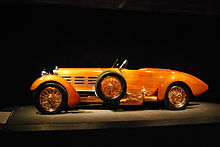One-off vehicle
A one-off vehicle is a vehicle designed for normal circulation and produced in almost single units following specific instructions from the customer. Generally the model is made on a small or large series, with significant technical, functional and aesthetic variations between each unit. In the field of vehicles authorized to drive, the production of unique vehicles is reduced to almost one unit in each case. The easiest cases to analyze are those of cars and motorcycles.
Unique automobiles and unique motorcycles are usually kept and displayed in museums. Aeronautical vehicles, with notable exceptions, are not preserved in the same way (due to accidents and disappearances). Naval vehicles feature a myriad of unique models. A non-exclusive base of examples could be the field of sailing yachts and motorboats.
Some cases of non-legalized vehicles may be included in this article if they have particularly noticeable characteristics, such as engine, chassis, and body types.
Origin of one-off
A one-off is something made or occurring only once, independently of any particular pattern.[1] First used in 1934,[2] this term is employed to differentiate singular items from those in a series: e.g. "the Lincoln Futura was a one-off". It has been suggested that it is a misspelling of "one-of", but this etymology is not supported by sources such as the Oxford English Dictionary.[3]
Cars
Before mass production, automobiles were handcrafted. First the whole car and then only the body on a factory-provided chassis. There are many unique specimens of that time. Many customers made the car custom-made. Of that mass of unique cars it is only good to expose a few. Those that, besides being in a museum, have some remarkable features.
Alfa Romeo 40-60 HP Castagna

The house A.L.F.A. Manufactured a 40/60 designated street car. Designed by engineer Giuseppe Merosi, it had a 4-cylinder in-line engine (with camshaft and cylinder head) and provided 70 hp (52 kW) with a top speed of 125 km / h. In the racing version, the power reached 73 hp (54 kW) and a speed of 137 km / h.
In 1914 the Milanese count Marco Ricotti commissioned an aerodynamic body to the specialized firm Castagna that allowed the speed of 140 km / h. This unique model was officially called "aerodynamics" and popularly was " Siluro Ricotti."[4][5]
1924. Hispano Suiza "Tulipwood"

The extraordinary and well-honored Dubonnet (the heir to the snack maker Dubonnet) commissioned a racing car in Hispano Switzerland based on the Boulogne model. The bodywork was commissioned to Nieuport, an aircraft manufacturer.[6][7][8]
- Engine: 6 cylinders in line, 8 liters, 200 hp
- Chassis
- Bodywork: From Virginia tulip strips of wood tucked in with brass nails (some talking about rivets) on wooden notebooks. There are doubts about some technical details. There are sources that speak of the structural elements of fir. Other authors indicate an aluminum sub-body. The total weight would be 78 kg. [9]
Despite the luxurious appearance it was a race car. It was sixth on the Targa Florio and the fifth on the Florio Cup.
1927. Bugatti Type 41 Royale
1931. Hispano-Suiza J12.
This luxury car was stripped naked, with only the chassis and engine. All J12s were unique. The engine was V12 at 60 degrees. The engine block was machined from a 313 kg casting block. The crankshaft rotated on seven bearings. Each cylinder had two valves operated by rockers from a central camshaft. According to the designer, Mark Birkit, this solution (apparently less sophisticated than the camshafts in the cilinde head) was chosen as less noisy.
- The Hispano-Suiza J12 appears in the film Borsalino & Co[10]
1938. Hispano-Suiza H6B Dubonnet Xenia
1939. Lagonda Rapide V12 Tulipwood Tourer
2006. Ferrari P4/5 by Pininfarina
American James Glickenhaus commissioned Pininfarina to create a special P3 racing body. The mechanical base was the Ferrari Enzo. The result would be designated with the reference Ferrari P4/5 by Pininfarina, authorized by the Ferrari house.[12][13]
It was the costliest new car in the world at its debut in 2017.[14]
References
- ^ Cordelia Hebblethwaite (27 September 2012). "Britishisms and the Britishisation of American English". BBC News Online.
- ^ "Definition of ONE-OFF". 24 November 2023.
- ^ New York Times: The Origins of ‘One-Off’, 2 July 2010
- ^ Gian Luca Margheriti (30 July 2015). 101 tesori nascosti di Milano da vedere almeno una volta nella vita. Newton Compton Editori. pp. 389–. ISBN 978-88-541-8612-5.
- ^ ALFA 40-60 HP Aerodynamics Castagna.[permanent dead link]
- ^ "Me and My Car: This Hispano-Suiza was built for speed". 19 February 2012.
- ^ White Elephantitis
- ^ A Review of Wave Rotor Technology and its Applications
- ^ Hispanic Switzerland H6 C Dubonnet 'Tulipwood' (1924). Kcslot logbook.[permanent dead link]
- ^ 1934 Hispano-Swiss J12 Ville coupe
- ^ "1939-Lagonda Rapide V12 Tulipwood Ttourer". Archived from the original on 2019-12-12. Retrieved 2019-12-13.
- ^ Carlos Viniegra (27 June 2018). Amos, lacayos y vasallos: Por qué el autoritarismo persiste en el siglo XXI y como enfrentarlo. Self Published Ink. pp. 249–. ISBN 978-607-8535-48-4.
- ^ Ian Norris (December 2006). Automobile Year 2006/07. Automobile Year. pp. 248–. ISBN 978-2-916206-04-2.
- ^ Harvey, Michael (27 May 2017). "Rolls-Royce debuts its stunning £10 million Sweptail - the most expensive new car ever sold". The Telegraph. Retrieved 2017-10-03.









